|
History of the Association
Based on a contribution by Don
Feesey.
(New!)
Streatham
Vale Yellow Box
Introduction
Prior to the
development of Streatham Vale in 1924, the land to the
south of Streatham Common Station was occupied by open
fields, orchards, woods and farms. Kidners Dairy Farm
and Greyhound Lane Farm produced arable crops for sale
in London and included two gravel pits in the area now
occupied by Aberfoyle and Broadview Roads. Further south
was Elm Farm where Farmhouse Road now stands. The old
farmhouse is thought to be the Vale Veterinary Clinic.
Crossing the Vale from Norbury to Mitcham the green
banks of the River Graveney meandered through the
fields. Although shallow, the river was prone to
flooding and in the 1950’s there were still residents
who could remember wading through the rising water by
the old Hermitage Bridge on the present A23, built on
the site of a ford going back to Roman times. To the
north of the ford part of the Roman road was uncovered
some years ago under the front gardens of the houses
adjacent to Hepworth Road.
Towards Norbury, the sports ground of the National
Westminster Bank [now NatWest] was situated on part of
the site of the Victorian racetrack which, from 1868,
held the ‘Streatham Races’ in the fields forming part of
the old Lonesome Farm. The race meetings attracted huge
crowds of racegoers, bookies and other notorious
characters. The course also included a water jump across
the River Graveney. Sadly, this exciting but
disreputable period of history came to an end in 1878
when the Racecourse Licensing Act banned racecourses
within a radius of 10 miles of London. The only reminder
of the track today is the slopes up to the platforms at
Norbury Station which were used for moving the race
horses on and off the trains.
Until 1924, the muddy rutted track that was to become
Streatham Vale was a continuation of Greyhound Lane,
previously known as Greyhown Laine, the Vale itself
known as Lonesome Laine – an ancient route from
Streatham to Mitcham. In the 19th century the failed
Village of Lonesome was built as a speculative venture
in the vicinity of the present Leonard Road. Nearby were
Pain’s fireworks factory, Mizzen’s farm and Potter’s
Lavender fields. In 1924, when the development of
Streatham Vale began at the top of the Vale, the road
crossed the bridge over the railway at Streatham Common
Station where the existing 19th century urban
development ended. In nearby Eardley Road, St. John’s
Church was built in red brick [now used as a balloon
factory], and subsequently the Streatham Vale Library
was built there. All the present houses on the south
side of Eardley Road between the Vale and the railway
arch and in Edgington Road are included in the
Association area.
Early Days
The first houses
were built in Aberfoyle Road. As the Estate grew the
rough roads were laid out with old railway sleepers set
into the ground to provide a firm surface and by 1928
nearly 2000 houses had been built. Once Streatham Vale
had been tarmacked, the London General Omnibus Company
agreed to run a service from Streatham Common to
Lonesome where the Salvation Army Hall was built. It was
soon extended to the Horse and Groom Public House at
Mitcham Common [now a health centre] and a private bus
company ran a ‘pirate’ bus called the Reliance which was
fast and also stopped where passengers wanted.
|
.jpg)
|
In those days
hardly anyone owned a car and bicycles were the
principal means of transport to work, although some
could afford a tram from Streatham to Westminster for 2d
[1p], or a workman’s return on an early morning train
for 9d [4p]. There was no inflation and prices remained
constant until the outbreak of the Second World War. The
new residents on the Estate were nearly all poor. Most
were first time buyers with money laboriously saved
since the First World War plus, to them, what must have
seemed huge mortgages to top up their savings to the
£500 or so needed at the time to buy a house.
|
.jpg)
|
Few people could
afford a telephone in their homes so the Association
campaigned for telephone kiosks and pillar boxes
throughout the Estate and for a Post Office and an
automatic dispenser for postage stamps. [One bought
stamps singly in those days!]. There was no
electricity. Street lights were powered by gas, with
a man on a bike going round to turn them on at night
and off in the morning. Visibility at night was poor
and the street lighting useless in the frequent
winter fogs. Unlike the road surface we have today
the roads were periodically stripped down to the
bare concrete by the Council and tarred with hot tar
from a mobile tar boiler. The road was then covered
in fine gravel pressed into the tar by a huge
steamroller.
Houses were heated by coal
fires and although two bedrooms upstairs were fitted
with small gas fires few people were able to afford
the extra shillings for the meter. Cooking and
lighting was by gas and the gas lights in the rooms
were fitted with fragile mantles to diffuse the
light which often disintegrated and had to be
replaced with care.
New shops were opened in the
Vale. In those days many more goods and services
were delivered directly to people’s homes than
today. There were the daily deliveries of milk,
bread and newspapers. Groceries, greengrocer and
meat were delivered from local shops by boys on
specially adapted bicycles. Coal and firewood were
delivered by horse and cart and carried through the
house to the ‘coal shed’ in the back garden in huge
hundredweight sacks on the backs of the coalmen.
Washing was almost always done on Monday mornings by
hand in the kitchen sink and those that could afford
them had cast iron ‘mangles’ in the back garden for
wringing clothes. There were no domestic
refrigerators and all fresh food was kept in the
ventilated larder built into every house. |
Formation of the
Association
In the 1920’s,
Streatham was within the boundary of Wandsworth Borough
Council.
In 1926, when
Wandsworth Council began to levy road charges to pay for
the properly surfaced roads and pavements they were then
making up, the residents got together to form an
Association in order to contest the charges.
.jpg)
The inaugural
meeting was held in Eardley Road School on 13 January
1926 when the ‘Streatham Vale Estates Property Owners
Association’ was formed but had no proper constitution
so, in 1927, the Streatham Vale Estates Property Owners
Association 1927 was formed. [The word ‘Estates’ and the
date of 1927 were dropped in 1931]. As a result of
Association representations the road charges were
reduced and the Association went on to oppose high
Rateable Values and high Council Rates on the
properties. As there was no Church Hall in Streatham
Vale Annual General Meetings of the Association were
held in St. Andrews Church Hall in Guildersfield Road.
The Rose was made the Association emblem in 1930 and has
appeared on stationery, medals and other official tokens
ever since. The Association also lent out decorating
equipment including a coloured cement spraying machine
for brightening up the outside walls. Road Stewards held
a stock of tap washers and stopcock keys for dealing
with dripping taps and other plumbing problems.
The Association was in business!
Road Steward
Organisation
From its
inception the Association has maintained a Road Steward
organisation throughout the Vale for the delivery of
Vale Topics, collection of annual subscriptions, and
maintaining a bridge between the membership and officers
of the Association.
Streatham Vale Library
As there was no
library nearer than the Tate Library in Streatham High
Road the Association petitioned for one to be opened
locally and this was built by Wandsworth Council in
Eardley Road in the early 1930’s. This was closed by
Lambeth Council in March 2000 having served the Vale
well for 70 years and the building is now a children’s
nursery. The Association continues to campaign for a new
library to be opened elsewhere in the Vale [see
Association Campaigns].
Streatham Common Railway
Station
First opened in
1862 as Greyhound Lane Station, it was renamed in 1875
as Streatham Common Station. The present station
building facing into Station Approach was erected in
1902. After the building of Streatham Vale the
Association campaigned for an entrance to be constructed
on the corner of Eardley Road which opened on 21 May
1929. Having served the residents for some 60 years it
was closed by British Rail in 1989 as being unsafe
despite strenuous opposition from the Association which
then launched a campaign to reopen the entrance. This
became one of the longest running campaigns in the
history of the Association, involving our Member of
Parliament, the Rt. Hon. Keith Hill MP, local
Councillors and many others. The campaign almost
succeeded in the late 1990’s but the train operator,
Connex, lost its franchise. In 2006 agreement was
finally reached with Lambeth Council and South East
London Trains [SELTRANS] for the total demolition of the
old structure and the construction of a superb new
entrance. See item on reopening the station entrance
below.
Streatham Vale
Football Club (New!)
The Streatham Vale Football Club was founded in 1928 and
occupied a football ground and grandstand on the ‘’Tudor
Sports Ground’ bounded by what is now Windermere Road,
Chilmark Road and Hassocks Road. A newspaper report
dated April 1931 refers to them having taken two seasons
to have won the sectional championship of their division
of the Streatham and District Football League. The
photograph below which shows the team in the 1933/34
football season recently came to light in a car boot
sale. It is not at present known when the club ceased
and today the land is covered by housing laid out to
form Oxtoby Way and Byards Croft. [with ack. to John
Brown and the Streatham Society].
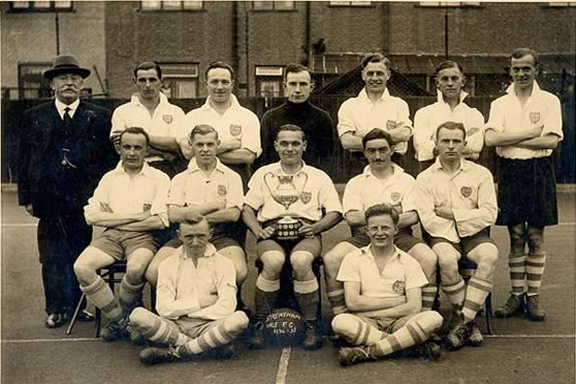
Vale Topics Magazine
In October 1927
our magazine ‘Vale Topics’ was first issued as a joint
venture with the Streatham Vale Sports and Social Club.
Donations were sought in 1928 for a Maintenance Fund but
in July 1929 donations ceased to be needed as the
advertisements generated sufficient money to finance the
magazine. Originally it was delivered to every house on
the Estate but, as printing costs rose, it could only be
delivered to members and, in the 1960’s, it became a
charge to Association funds.
Local Schools
Many new
residents had young children so the Association pressed
for new local schools. Granton School was opened in June
1929 and Woodmansterne School in September 1930.

Children from Granton School visiting
Swanage on a 'School journey' 1938.
Streatham Vale Park
The site of the
Park at Lonesome, just inside the border with the London
Borough of Merton, consisted of 5.5 acres of land which
had been acquired by R H Miller, the builder of the Vale
from Abercairn Road to Eardley Road, from the Ellison
Estate [after whom Ellison Road is named]. It was then
contaminated industrial land previously used as
brickworks. R H Miller gave it to Wandsworth Council in
1925 for the purpose of creating a park on the site.
Having taken the land over at a time of financial
stringency, Wandsworth Council had no extra money
available and the ground lay undeveloped. No-one can now
say how long that would have continued had it not been
for Stanley Grist. Stanley, who lived in the Vale, was
an early member of the Executive Committee holding a
variety of posts from 1925 to 1929 when he was elected a
Wandsworth Councillor.
There is no doubt that Stanley threw himself into
Association work in general and in particular the
Association campaign to build Streatham Vale Park with
such effect that, at the opening ceremony on Friday 26
June 1931, the Mayor of Wandsworth paid tribute to him
in glowing terms. “Councillor Grist”, he said, “(was)
always in evidence and so (pressed) the needs of
Streatham Vale that instead of the word ‘Calais’ on the
hearts of the deceased members of the Parks and Open
Spaces Committee would be found the words ‘Streatham
Vale’”. The Mayor also reminded the people of Streatham
Vale that the Park was theirs and added that the Council
was determined to enlarge the Park as soon as possible
by the addition of the adjacent Council dumping ground
of Lonesome. Sadly WWII intervened and the Park was
never extended.
Upon being opened, the Park consisted of a recreation
ground, which had been opened the previous year, and a
wide landscaped area. From that time onwards the people
of Streatham Vale cared about their Park and looked
after it, but, during the War years, much of the Park
was converted into allotments after demands by the
Association for more land on which to grow produce which
continued in use for some years after the end of the
War. In 1952 the new bowls green and tennis courts were
opened along with a children’s shelter and the Streatham
Vale Bowls Club was constituted. Sadly that was forced
to close down in 1992.
Today the Association is a member of the ‘Friends of
Streatham Vale Park’ and supports the activities of the
‘Friends’ in promoting, improving and safeguarding the
Park.
The River Graveney
The sloping
green banks of the River Graveney had often been flooded
and now, with houses close by, the London County Council
began constructing deep concrete culverts. On 2 November
1930 a torrential thunderstorm occurred and this,
combined with the culverting work in progress, caused
the gardens of houses between Hawkhurst and Helmsdale
Roads to be submerged up to back door level. The
Association took the matter up with the LCC who admitted
liability and compensated the home owners.
Street Trees
In 1927 the
Association canvassed residents about having tree-lined
roads. As a majority of the residents were in favour of
this proposal [1495], Wandsworth Council planted 1137
trees towards which all residents contributed. The
Council also agreed to maintain the trees and replace
any losses. On 8 February 1930 a special ceremony was
held to celebrate the planting of the final tree by the
Mayor at the junction of Churchmore Road and Streatham
Vale. Subsequently, two more trees were planted outside
the Church which was built in 1932. The Association
maintained a map of the position of the trees and
carried out periodic checks.
The Church
The Church Hall
in Churchmore Road was originally designated as St.
Luke’s Church. Later, residents contributed to the cost
of a proper Church and the children contributed to a
‘farthing fund’. The Holy Redeemer Church standing today
was opened in 1932 and was established as the Church of
the Holy Redeemer as a memorial to a Clapham religious
sect which had been linked to William Wilberforce and
the Bill for the Abolition of Slavery.
In addition there was a Baptist Mission Hall in Leonard
Road and a Salvation Army Hall at Lonesome was opened on
14 June 1930.
Streatham Park Cemetery
Situated in nearby Rowan Road, the Streatham Park
Cemetery has over the years been the final resting place
of many good people from Streatham Vale. It comprises
two sections, one of 70 acres opened in 1920 and an
adjoining area opened in 1932 for those of the Jewish
faith. A feature of the cemetery is a memorial to
variety artists and one to the comedian Will Hay.
World War II
In 1939 War was declared on Germany and the Association
prepared to ‘do its bit’ for the war effort. On 23
September the Association set up an Emergencies
Committee joining the Streatham Comforts Fund helping to
raise money for cigarettes and woolly jumpers for the
men on active service.
Anderson shelters were put up in back gardens and a
local Vale man invented an indoor shelter that so
impressed Herbert Morrison MP, Minister for Home
Security, that it was put into production and became
known as the Morrison Shelter.
An anti aircraft battery was installed on the
Westminster Bank Sports ground. Sadly this did not
prevent houses in the Vale from being bombed but the
Vale folk were a hardy lot and the Association engaged a
solicitor to advise residents on making claims for ‘War
Damage’ to their houses.
As the war went on and food shortages became more acute,
the Association handed out thousands of self sufficiency
leaflets and obtained permission to dig more allotments
in Streatham Vale Park and the playing fields of
Woodmansterne and Granton Schools. Association flower
and vegetable shows continued in the Holy Redeemer
Church Hall including one which was interrupted by an
air raid. Some residents took refuge in the air raid
shelter by the Church and even in the trenches dug in
Streatham Vale Park but many remained in the Hall until
the ‘all clear’ was sounded. The show then resumed. This
was a brilliant example of the ‘London can take it’
attitude of Vale people who, after the War, were praised
in the House of Commons by the local Member of
Parliament.
Just as it looked as if the German Army was in retreat
after the Allied Landings in Normandy, Hitler unleashed
his new secret weapon, the V1 flying bomb. Bombs fell on
London and Streatham Vale was not spared. Whole blocks
of houses were damaged or razed to the ground. In all
154 houses had suffered damage from the bombing and the
Association helped home owners to obtain licences for
repairs and compensation from the War Damage Commission.
A section of Sherwood Avenue between Drakewood and
Nettlewood Roads had been completely destroyed and the
London County Council set up a day nursery on the site
which it decided should become permanent in favour of
the rebuilding of the original houses and sought a
compulsory purchase order for the site. The Association
fought this until the nursery was closed in 1952. The
houses were rebuilt and the original owners moved back
in to the properties. During this fight the Association
met all the costs including the legal costs. It is
doubtful that, if the owners had acted individually,
they would ever have regained their homes without
incurring expenditure which, at the end of the War, they
could have hardly afforded themselves.
Association Allotments
The Association Allotment Grounds situated adjacent to
the Holy Redeemer Church were purchased in 1930 for £100
and comprise 60 allotments. [A full section on the
allotments appears under its own heading on this
website.]
Flower and Vegetable Shows
Each year the Association held a Gala Day and Flower
Show in Woodmansterne School which included sideshows,
demonstrations of various kinds and children’s races.
This was transferred to Granton School in the early
1970’s. Today the Association holds two flower and
vegetable shows in the Hall of the Holy Redeemer in July
and September at which members compete for the
Association Cups and Medals.
Transfer To Lambeth Council
In 1965, boundary changes in London transferred a large
area of Streatham including Streatham Vale from
Wandsworth to the London Borough of Lambeth.
London Motorway Ring Road
In 1966 proposals for a terminal of the M23 and a linked
ring road would have cut through the Vale destroying
hundreds of houses. The Association set up a new
Motorway Sub-Committee to fight the proposals. A public
meeting was held in Streatham Baths for residents of
Streatham Vale and Norbury with representatives of the
Greater London Council and our MP, Duncan Sandys. The
Association conducted a special collection from members
to build up a fighting fund of £1000 to pay for legal
representation at the public inquiry. As a result of
strenuous efforts by the Committee and the Association’s
legal advisor, substantial evidence was collated in 1973
for presentation to the public inquiry. However the GLC
put both schemes on hold until they were withdrawn in
1976.
Notwithstanding the efforts of the Association both the
Vale and nearby Norbury suffered severe ‘motorway
blight’ during this period. Many small shops in Norbury
closed and the character of the area declined. Large
numbers of homes were acquired by the GLC who used them
to provide temporary housing. Ownership of these houses
was eventually transferred to Lambeth Council, many of
which have been sold to the original tenants under the
right to buy scheme.
Council Rates and the Poll Tax
During the 1970’s and 80’s the Association campaigned
strenuously against the unfairness of these systems and
the freedom of Councils to levy rates above inflation
which in those days was high. Our Member of Parliament,
William Shelton, put forward a Private Members Bill for
capping the Poll Tax which was defeated by 49 votes.
However, the Poll Tax was eventually withdrawn following
substantial public opposition and civil disorder in the
country as a whole.
Channel Tunnel Freight Train Service
In 1974, plans were proposed for freight trains from
Folkestone to be routed through the Vale on tracks at
the side of the railway behind Glenister Park Road
before going under ground. Examination of the proposals
revealed that the trains would have been exceedingly
long and slow-moving creating unacceptable levels of
noise and vibration. The Association took an active part
in opposing these plans.
In 1994 a separate plan was put forward by ‘Central
Railway’ for a heavy goods railway line to follow the
railway line and, until recently, a member of the
Association’s Environmental Committee continued to
represent us on the NATCRAG [National Central Railway
Action Group] Committee. Although it is now unlikely
that the Central Railways proposal will be routed
through the Vale, we remain on the NATCRAG mailing list
for information purposes.
Health
In 1985 the Association took part in planning a
composite health centre which included both medical and
day centre facilities which was established in Polworth
Road, Streatham, as the Whittington Centre. The
Association now forms part of the Steering Committee of
the Primary Care Trust in respect of health care in the
Vale. [See Association Campaigns].
Road Safety
Even in the 1930’s articles were printed in Vale Topics
concerning the dangers of speeding cars. Since its
inception the Association has taken an active part in
setting up road traffic signs on the Estate as well as
pedestrian crossings, traffic lights and guard rails at
important spots. Traffic calming measures in some of the
residential roads on the east side of the Vale were
installed by Lambeth Council in the 1990’s.
In 2004 Lambeth Council imposed a 20mph speed limit in
the residential roads and, also in association with
Transport for London, installed a bus lane in the
northbound carriageway of Streatham Vale [see also
Association Campaigns].
Neighbourhood Watch
Crime in the Vale was not much of a problem until 1980
when the Association started to keep in regular touch
with the local beat officer. In 1984 a Neighbourhood
Watch Scheme was set up. It was one of the first and
largest in the country taking in over 2000 properties.
As not all residents were Association members, it was
not run by the Association but the Association funded
it. The scheme thrived and Vale Topics carried many
articles advising people how to combat crime and protect
property and vehicles.
In 2004 the Association decided to take Neighbourhood
Watch directly under its wing. The existing NW Committee
continued to meet each month with police officers but
now included a member of the Environmental Committee who
acted as a bridge with the Association. This arrangement
reinforced the existing activities of the Environmental
Committee such as reporting dumped cars and graffiti. It
was represented on the Streatham Crime Working Group.
Through the SVPOA connection with Neighbourhood Watch,
matters reported to the Committee by the local police
are now promoted widely through Vale Topics.
Streatham Common Railway Sidings
From 1930 to 1977 coal was unloaded at a wharf between
the railway and Glenister Park Road. After it closed the
ground was given over to a variety of uses before
proposals were put forward by Lambeth Council to
schedule the land for light industrial use. The
Association considered this was inappropriate for a site
in the middle of a residential area and lodged
objections. Whilst negotiations continued the site
became overgrown and derelict and, in 1983, a young boy
was murdered there.
A number of other proposals were put forward including
the construction of a new Sainsbury’s supermarket.
However, after a public inquiry, the Association was
able to assist Sainsbury’s to move to their present site
at Streatham Common. There then followed more
negotiations with Lambeth Council, who still insisted
the land should be reserved for light industrial use
instead of the proposal by the owners of the Texas DIY
chain to build a new store there. Eventually, assisted
by the Association, the Texas store was built although
the Council refused to allow the construction of the
integral garden centre originally planned.
Today the store is Homebase, who have redeveloped the
building by raising the roof, adding a new floor and
constructing a garden centre. A casualty of this was the
demolition of the parade of small shops fronting the
site despite an active campaign by the Association to
save them. A condition of the loss of the shops, imposed
by Lambeth Council in response to a further campaign by
the Association and local Councillors, was that Homebase
should meet the cost of some substantive improvement to
the Vale but in the event they would only agree to
provide improved street lighting at the front of the
site.
Change of Name
In 2001 the name of the Association was changed to
‘Streatham Vale Property Occupiers Association’ in
recognition of the numbers of residents who rent
property in the Vale and were unable to become members.
Recent Housing Developments in the Vale
In 1987 Lambeth Council designated the disused railway
sidings to the rear of Abercairn Road for new housing.
However, the Association was legally unable to object
despite having reservations as to the nature of the
scheme which included the demolition of four houses to
construct an access road. The development itself is
outside the boundaries of the Association. Also, in the
early 1990’s, a scheme to construct an area of new
housing to the rear of Glenister Park Road and the Texas
DIY store [now Homebase] was agreed by Lambeth Council
and was incorporated into Streatham Vale as Woodgate
Drive. In the late 1990’s the old Natwest sportsground
was sold. Part of the resultant housing development is
accessed from Woodmansterne Road but remains outside
Streatham Vale as it is situated in the Borough of
Merton.
Reopening of
the Eardley Road Entrance to Streatham Common Station
On Monday 14th May 2007 Streatham Common Railway
Station’s Eardley Road entrance was officially opened by
Tom Harris MP, Minister for Transport, in a ceremony
attended by residents and members of the Association,
The Rt. Hon. Keith Hill MP, and the Mayor of Lambeth,
together with representatives of the train and rail
operating companies and local Councillors. The reopening
of this entrance highlighted the end of a near 20 year
campaign by the Association and demonstrated the
persistence of local residents over many years to
achieve this goal. In particular the late Charlie Ruff
who started the campaign in the 1980’s and the late Alan
Bedford who, as Chairman of the Environmental Committee,
took the campaign forward to its final successful
conclusion should be mentioned.
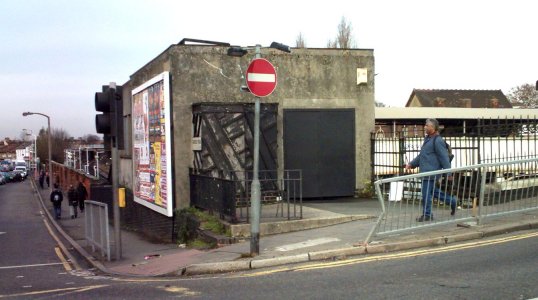
Before restoration |
|
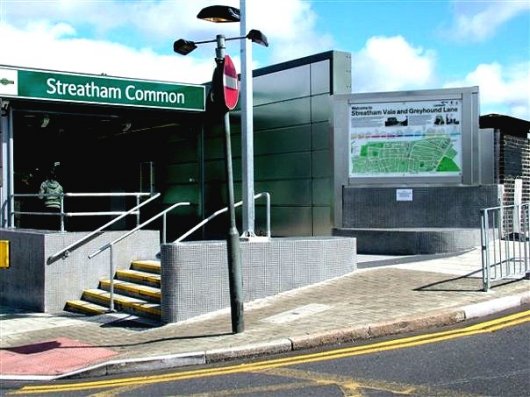
The new entrance |
The new station entrance proved not only be of great
benefit to train passengers and residents alike
approaching from Streatham Vale and Eardley Road,
providing a more convenient means of access to and exit
from the station, but incorporated an innovative
stainless steel and glass design with bright lighting,
CCTV and a ticket issuing machine. Unlike the old
entrance it did not contain small shops and kiosks so
the full width of the available area could be used by
passengers and natural light is provided by the large
windows overlooking Eardley Road. Facing towards the
Vale, a mural of the area incorporating a map, places of
interest and historical notes was installed in
consultation with local Councillors and the Streatham
Society. Improvements to the pavements outside the
entrance have also been carried out to make a step free
access to the station.
In opening the station Tom Harris MP, said, “I am
pleased to see these improvements at Streatham Common
Station which will mean easier journeys for passengers
and a nicer station for the people of Streatham. This
will complement £2.3M of future work in putting a step
free route through the station for disabled people.”
Streatham Vale Bus Lane
In 2003
the Association learned that Lambeth Council and
Transport for London were contemplating
installing a bus lane in the Northbound
carriageway of Streatham Vale between Braeside
Avenue and Aberfoyle Road. The view of the
Association was that due to the narrowness of
the Road this proposal was impractical and as
the proposed lane was less than half a mile in
length and did not connect with any other bus
lane it would be ineffective in reducing journey
times of the two bus services that would be
using it. It was also learned that the bus lane
would be controlled by a draconian bus lane
camera operated remotely.
The Association’s view was supported by the
majority of Streatham Vale residents but despite
this opposition the Streatham Area Committee of
Lambeth Council voted to accept the proposal.
The bus lane was installed in the summer of 2004
but by September the Association was receiving
reports that very large numbers of parking and
bus lane infringement penalty tickets were being
issued and that the Vale shops had experienced a
substantial drop in customer numbers. A petition
for the removal of the bus lane signed by 500
Vale residents was presented to the Streatham
Area Committee on 29 July 2005. A copy was also
sent to Valerie. Shawcross our member on the
Greater London Council who supported the
campaign.
On 30 November 2005 the committee voted
unanimously for the removal of the lane.
The Vale did however retain the new pedestrian
crossing complete with re-installed traffic
islands near Bencroft Road, the improved parking
lay- by outside the Co-op and the other
additional parking installed in connection with
the bus lane. The cost to the London council tax
payers for the installation and removal of the
lane was sadly substantial but demonstrated the
folly of local government failing to take
account of the views of residents.
|
|
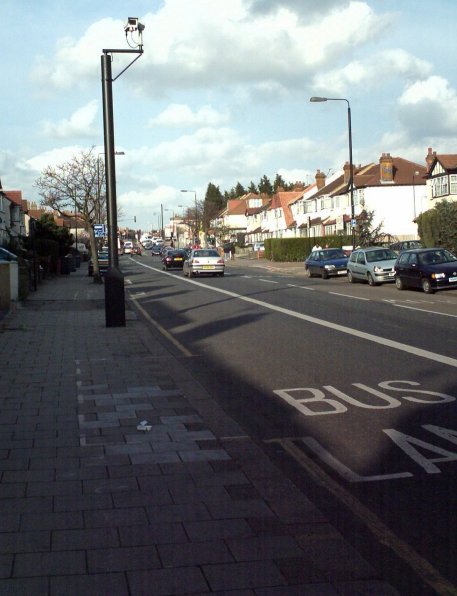 |
GP Clinic
Woodgate Drive
| On Monday 1 December 2008 GP’s practising in Greyhound
Lane transferred their practice to the newly built
surgery at Woodgate Drive. This is was the culmination
of a campaign started by the Association in 2002/3, in
which we put forward proposals for a number of sites in
the Vale to ensure that Vale residents were not left
without a local surgery when the new group practice was
built at Baldry Gardens on the A23. The campaign was
complicated by the lack of a fully satisfactory site
meeting the criteria of the Lambeth PCT and it was by no
means certain that we would succeed. The Association set
up a joint steering committee with the Lambeth PCT,
raised a petition of over 500 signatures and promoted a
letter writing campaign by residents. The Association
was supported by Councillors of both main local parties
and The Rt. Hon.Keith Hill MP. The Association lobbied
the Lambeth Council Health Scrutiny Committee, the
Lambeth Streatham Area Committee and persuaded the local
papers to print supporting articles. |
|
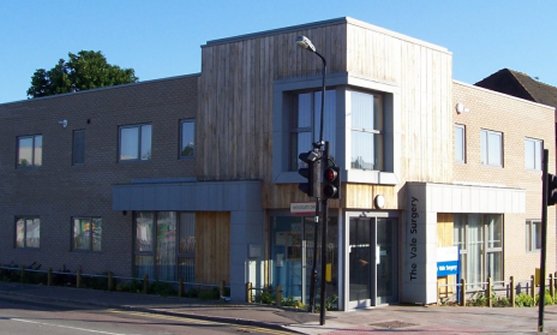 |
| |
|
|
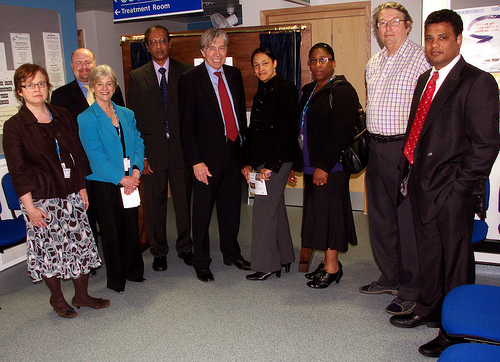 |
|
As a result of these activities, the Lambeth PCT
undertook a survey of possible sites in the Vale and
Greyhound Lane and agreed at considerable expense to
carry out a feasibility study on the near derelict
Lambeth Council allotment site Between Bridgewood and
Grayscroft Roads for a combined GP surgery and library.
When it became clear that this could not be achieved,
the Association put forward its ultimately successful
proposal of the smaller site at Woodgate Drive which had
previously been granted outline planning permission for
the construction of two semi detached houses. The
establishment of the surgery opened a new chapter in
health care in the Vale, ensuring residents would have a
GP surgery within walking distance for the foreseeable
future.
The group on the left:
The Rt. Hon Keith Hill and officers of the
Lambeth PCT opening the clinic on 1 May 2009
|
Streatham
Vale Yellow Box
The Streatham Vale yellow
box was installed by Lambeth Council at the
junction of Eardley Raod and Streatham Vale in
the 1990’s, however Because of the complexity of
the junction it was not difficult for even
experienced motorists to be trapped in the box
either when the out of sight traffic lights at
the greyhound Lane/Estreham/Ellison junction
changed causing a tail back over the bridge or
when the lights at the Vale /Woodgate Drive
junction did also causing a tail back on the
opposite side of Streatham Vale. The former
caused a welter of letters to the Streatham
Guardian in 2007 and the lights were eventually
rephased improving the situation somewhat,
however this still left the cars turning right
from Eardley into the Vale being trapped in the
box when the lights changed on the Woodgate
Drive junction.
The Association became extremely concerned that
large numbers of motorists using the Vale/Eardley
junction were being unfairly targeted by Lambeth
Council and In 2007 it was found that cars were
being issued with penalty notices claiming the
yellow box was in Eardley Road when of course it
was in Streatham Vale. It was only the CCTV car
which was in Eardley Road. This was appealed to
the PATAS independent adjudicator by Councillor
Julian Heather representing a constituent. The
adjudicator concurred that the notice was
defective and upheld the appeal.
|
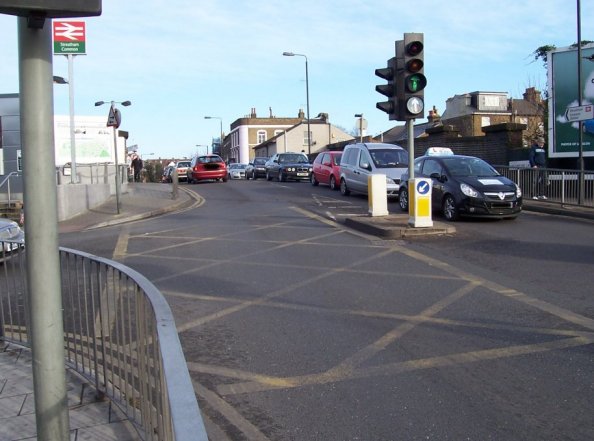 |
An identical
appeal represented by the Association was due to be
heard a few days later but Lambeth did not press the
case and we won by default. Subsequently we applied to
the PATAS adjudicator for costs and £47.00 was awarded
by the adjudicator. In so doing the adjudicator
commented “…………I find the conduct of the local authority
to have been wholly unreasonable”…..and directed Lambeth
Council to pay the costs.
In 2008 a local motorist appealed against the issuance
of a penalty notice for turning right in the box when
turning right from Eardley Road to Streatham Vale. In
summing up his reasons for allowing the appeal the
adjudicator stated inter alia he was satisfied ”….the
appellants car entered the box junction for the purpose
of turning right and stopped within the junction for so
long as it was prevented from turning right by vehicles
which were stationary whilst waiting to complete a right
turn…..”
After the SVPOA submitted a copy of this judgement to
Lambeth Council through local Councillors it was agreed
that:
1. Vehicles would no longer be issued with penalty
notices for waiting in the Vale/Eardley yellow box to
turn right into the Vale.
2. The yellow box in front of the LEFT HAND lane of
Eardley Road would be removed so motorists turning left
onto the bridge would not run the risk of being
penalised.
3. Motorists would only be issued with penalty notices
if they are proceeding up the Vale towards the railway
bridge and stopped illegally in the yellow box.
This was victory for local residents, Councillors and
the SVPOA and another demonstration that Lambeth Council
would do a lot better if it listened to local residents.
The Association Today
Today the Association represents over 2000 residents in
Streatham Vale. Its activities are strictly non-party
political and range from campaigning on issues vital to
the preservation of the Vale as a family housing area to
maintaining its allotments. It works closely with
Lambeth Council, local Councillors and Streatham’s
Member of Parliament, Keith Hill, to achieve these ends.
Since its construction in 1924 the Association has
defended the area from innumerable threats to its
existence. Although standards of living and the value of
the homes have risen to a level undreamed of by the
first residents of 1924, the Vale has maintained its
integrity and still has the feeling of a community
amidst the changing face of South London. Whether it
continues to be able to resist undesirable changes
remains to be seen. The Association is only as strong as
the resolve of its members but, from the evidence of the
last 80 years, it will continue to successfully defend
the Vale for the foreseeable future.
SVPOA
Updated February
2009
|



.jpg)
.jpg)
.jpg)







